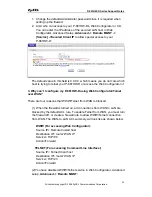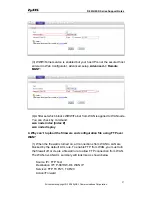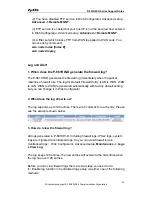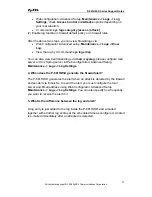
P-661HW-D Series Support Notes
4. Where can you find 802.11 wireless networks?
Airports, hotels, and even coffee shops like Starbucks are deploying 802.11
networks, so people can wirelessly surf the Internet with their laptops.
5. What is an Access Point?
The AP (access point also known as a base station) is the wireless server that
with an antenna and a wired Ethernet connection that broadcasts information
using radio signals. AP typically acts as a bridge for the clients. It can pass
information to wireless LAN cards that have been installed in computers or
laptops allowing those computers to connect to the campus network and the
Internet without wires.
6. What’s the difference between IEEE802.11a/b/g?
The IEEE 802.11 is a wireless LAN industry standard, and the objective of
IEEE 802.11 is to make sure that different manufactures' wireless LAN devices
can communicate to each other. Below is a brief comparison for the
IEEE802.11 a/b/g:
Publish
Time
Frequency
Band(GHZ)
Data Rate(Mbps)
Compatibility
IEEE802.11a 1999
UNII
Band
5.15~5.825
6,9,12,18,24,36,48,
54
Only work with
802.11a
devices
IEEE802.11b 1999
ISM
Band
2.4~2.4835
1,2,5.5,11 -
IEEE802.11g 2001
ISM
Band
2.4~2.4835
6,9,12,18,24,36,48,
54
Backward
compatible with
802.11b
devices
7. Is it possible to use wireless products from a variety of vendors?
Yes. As long as the products comply to the same IEEE 802.11 standard. The
Wi-Fi logo is used to define 802.11b compatible products. Wi-Fi5 is a
compatibility standard for 802.11a products running in the 5GHz band.
8. What is Wi-Fi?
The Wi-Fi logo signifies that a product is interoperable with wireless
networking equipment from other vendors. A Wi-Fi logo product has been
tested and certified by the Wireless Ethernet Compatibility Alliance (WECA).
The Socket Wireless LAN Card is Wi-Fi certified, and that means that it will
work (interoperate) with any brand of Access Point that is also Wi-Fi certified.
9. What types of devices use the 2.4GHz Band?
Various spread spectrum radio communication applications use the 2.4 GHz
40
All contents copyright © 2006 ZyXEL Communications Corporation.
















































